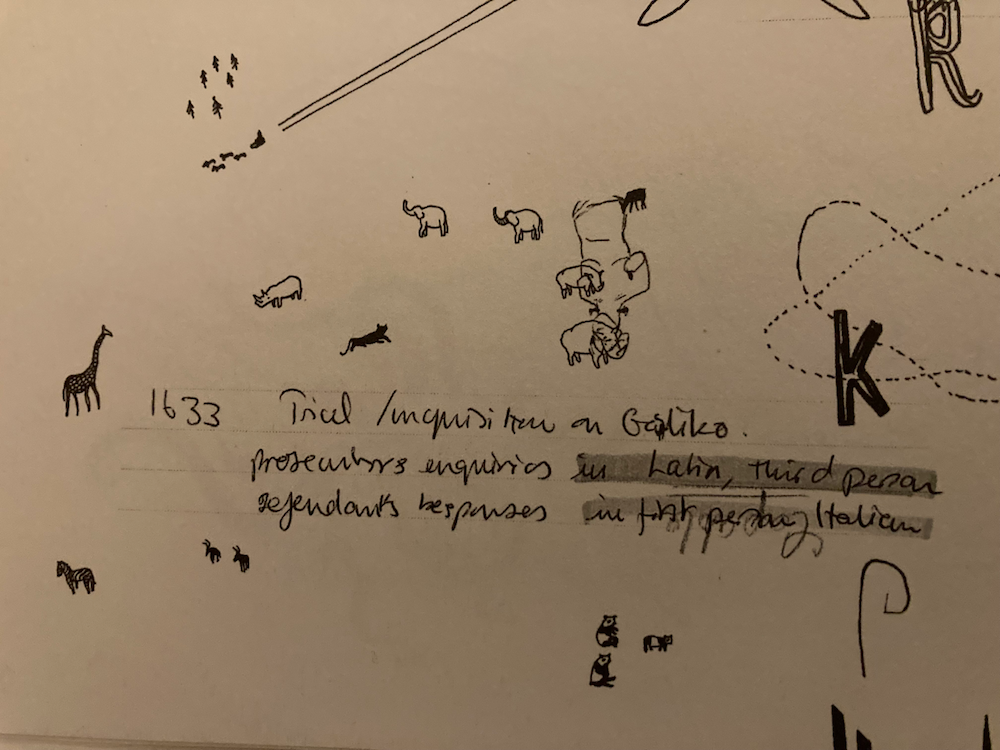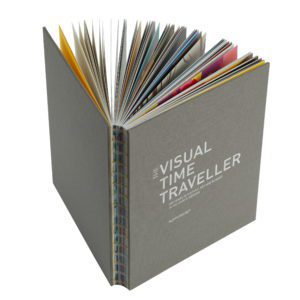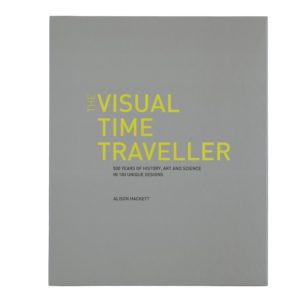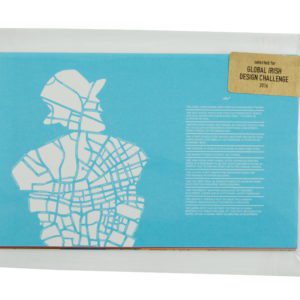The Dialogue (with apologies to Galileo) This is a short script I wrote and read at the end of my inaugural Visual Time Traveller talk I presented in the RDS Library, on the 2nd of April 2014, when launching the exhibition (2 Apr – 15 May 2014). The first draft was written on 9th March 2014.
Scene: It is March 2014. At a dinner party. Alison Hackett has just been introduced to the person she is sitting beside who opens with a politically safe question:
“So what keeps you busy Alison?”
“Mainly the publishing house I set up recently – it’s been keeping me pretty busy.”
“Really? What’s it called?”
“21st Century Renaissance.”
“And have you published anything yet?”
“Yes. A book called The Visual Time Traveller. It’s by a first time author.”
“Is it an e-book? Can I get it on Kindle?”
“No. It’s only in print.”
“That’s brave. I thought all the money was in digital and apps these days and print was dying. Is it fiction?”
“No. It’s an illustrated coffee table book on history.”
“Which bit of history? I love history.”
“About 500 years. Renaissance to the present day.”
“Wow! Ambitious. A lot to cover in one book.”
“Well, you know the Reduced Shakespeare Company and how they reduce a Shakespeare play to 2 minutes? This book is similar – it is a history since the Renaissance condensed into 5 year time gaps. 12 facts from each five-years are woven into a graphic design – there are a hundred of these.
“Sounds very ambitious. Was he working on it for long?”
“It’s a she. It took her about a year and a half from beginning to end.”
“Who’s the market for the book then?”
“Well, this is one of the questions that really annoyed her. When she came to me first she said the book was for everyone. I told her this was just stupid. All publishing was for niche markets these days – you had to think of the target market in order to figure out how to write it. So after a few arguments about this she started telling me the market she had in mind was the ‘thinking graduate’. But, you know, between you and me, I think she was only saying this to shut me up and to have an answer for people who were constantly asking her this question. But the thing is, now that it’s published, it’s actually quite hard to say who the book is ‘not for’….it is a pretty broad market alright.
“But it sounds like a very risky project for a publisher. Did she try any other publishers?”
“She did. She was declined by 7 others. Some big names.”
“So why did you decide to take it on?”
“I guess the concept sounded intriguing and she was really determined she was going to make it happen. I just had a gut feeling there was something original in it and it might be a runner.”
“So the book is full of designs and illustrations? Is she a designer?”
“No. A lot of people think that. She’s a maths and economics graduate – and worked for the Institute of Physics for almost 13 years.”
“And who designed the book?
“A design house called Origin.”
“Irish?”
“Yes here in Dublin, Wicklow Street.”
“How did you decide on the design style for the book? I guess it’s important that a coffee table book is beautiful.”
“Well the choice of design style should have been my department but this author was extremely difficult. She insisted she had to be part of the design process. She wouldn’t allow a design template for the book, which was totally mad.”
“I suppose a publisher shouldn’t let an author control those aspects of a publication – you must want to develop your own particular house style?”
“Absolutely. I told her that this was not the way it was done. Publishers look after editing, design and production and authors stay out of that bit – they just need to focus on their writing. But she was very stroppy and said I couldn’t publish it unless she was allowed to be involved in the design process.”
“And how did you cope with that? You must have hated the interference.”
“We didn’t really know what to make of her – it was all very unorthodox. She wanted no page numbers, no logos, no two designs were allowed to be remotely similar because she wanted it to look like different designers had created each design. Then she wanted them to stop using the computer so she could see what they’d come up with using pen and paper. She argued about fonts – she didn’t want the same font on every page and she wanted handwriting whenever possible. She even started trying to draw things herself. It was a pain in the neck as this was making it less and less likely that publishing the book was ever going to be profitable for me.”
“Oh God. How did you manage all this – it sounds like a major headache?”
“Well the main designer, Garrett, who was working on the project said that we were going to need an illustrator involved as this was going to be the only way she was going to get the kind of thing she was looking for – he seemed to get what she was about – not everyone did – I’m telling you she’s a couple of standard deviations away from normal.”
“And did you get an illustrator?”
“Well yes they got a designer in who was strong on illustration and typography and once some of the early illustration concepts started coming through she calmed down and realized we were going to be able to create this vision she had.”
“Was she happy with the final book? Was there a book launch and all that stuff?”
“Yes. She adores the book. She says it went way beyond and better than she had ever imagined or dared to dream.
“Does it have a beautiful cover?”
“Well here’s the thing. Having gone on and on about the illustrations and the hand drawn stuff and wanting hand-writing instead of text, towards the end of the whole project she announces to me that she’s now got the whole ‘illustration thing’ and ‘hand-writing’ out of her system and she wants to use straightforward text in a regular font on the cover – no illustrations. She said she wanted it to be cool and designer-ish looking.”
“So from the cover you wouldn’t know there was all this design inside?”
“Yes. Exactly.”
“But wasn’t that mad from a marketing point of view? Wasn’t it going to make your job selling it much more difficult? Why didn’t you over-rule her on that?”
“Because you couldn’t over-rule her on anything. She was very stroppy and opinionated about how to publish. She even got in on the production side. She appeared one day with a cookery book that had this exposed spine and stitching that allowed the book to lie open flat and said that this was the way her book had to be. You know, the way she carried on you’d think she was self-publishing the book.”
“And was it printed in Ireland?
“No. Printed in the Netherlands. The designers really liked the whole idea of the exposed spine – and then treated it as part of their own creative process by considering the colours that could wrap around to be visible on the spine – a huge amount of creative and technical skill went into the production – it was an awful lot of work for them to get this right – but they did an amazing job.”
“So how are sales going? Will you break even?”
“Not bad. We sold a lot at launch. It’ll be a while before I break even but if there’s enough demand and hopefully a reprint at some stage we should be ok.”
“Have you had any publicity yet?”
“No. But after all the investment in the design and production I couldn’t afford to hire a PR or marketing team – let alone a sales and distribution team. I’m a bit of a one-man band. Or, to be more accurate, a one-woman band!”
“But it sounds like such an interesting book surely papers and media will review it? You should go onto the radio to talk about it. Or what about the Late Late?
“It might look easy but when you’re unknown it’s very hard to breakthrough. I explained to her that in taking her on as a first time author she would have to make a big effort in getting publicity and marketing the book herself – I had absolutely no budget left.”
“But she hasn’t had any luck yet?”
“Well. Same stuff as everything with her. She had her own views about what would work with publicity. I’d given her some of the books to distribute to the media which would definitely have got us traction somewhere. But she was very protective about these books and got very cross with me saying she wasn’t giving them out free on the off-chance that she’d get a review. She said something about hundreds of books sent in by publishers ended up sitting on journalists and editors desks that were never even opened and would never get reviewed and they wouldn’t ever send them back.
“Crikey – she bucks the trend with everything!”
“Yes! I got very frustrated with her at this point. I told her that this was not how the publishing world worked. All publishers sent newly published books in to media and would not expect to get them back.
“And she didn’t take your advice?”
“She got even crosser with me. She said one journalist had actually lied to her. She was so indignant. She’d told me she’d emailed him with an invite to the launch and he’d replied saying unfortunately he couldn’t come but he was interested. After the launch she emailed him again to see if he was still interested (telling him the book was selling very well in Hodges Figgis, and was even lined up beside Seamus Heaney’s collection and Fintan O Toole’s 100 objects.) He replied to her that this was great and he was looking forward to seeing the book when the copies came in. She gets back to him explaining that the books weren’t going to be ‘coming in’ – but that she could drop one in for him personally. He emailed her back not to worry about getting him a copy he’d pop up to Hodges Figges to buy one. And then she looks at me. All hurt and shocked. She says, ‘you know I’m pretty sure he never went and bought one.’
“Oh dear. Is she a bit naïve?”
“Yes – but she’s an enthusiast and very persistent so eventually I’d say we’ll get some traction – but she gets very dispirited at times. At one stage she was so frustrated by the rejection she announced that she was thinking of burning the books.”
“What?!!”
“She said that she was sick of trying to get the media’s attention and that if the books were gone she’d no longer have to worry about trying to get a review and get them sold and she wouldn’t feel like a failure and she could get on with the next bit of creative writing. And she said that the existing books that people had already bought would become incredibly valuable they’d be so rare.”
“Oh my God – I presume you talked her down from that idea?”
“Ignored it – best way to deal with authors – they’re all a bit crazed – but I did make sure she didn’t know where the lock up for the books was – and there’s a strong padlock on the door.”
“Hah! So I’d better get a copy before she burns them. What’s her name – did you say it already? She sounds like high maintenance.”
“She is. Her name? It’s Alison Hackett.”
Galileo’s “Dialogue Concerning the Two Chief World Systems” is the publication of 1632 in which he defends the Copernican heliocentric model. This publication prompted his trial by Inquisition in which he was found “vehemently suspect of heresy”, forced to recant, and spent the rest of his life under house arrest.





